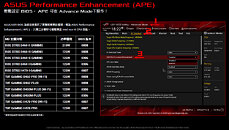- Joined
- Oct 9, 2007
- Messages
- 47,849 (7.39/day)
- Location
- Dublin, Ireland
| System Name | RBMK-1000 |
|---|---|
| Processor | AMD Ryzen 7 5700G |
| Motherboard | Gigabyte B550 AORUS Elite V2 |
| Cooling | DeepCool Gammax L240 V2 |
| Memory | 2x 16GB DDR4-3200 |
| Video Card(s) | Galax RTX 4070 Ti EX |
| Storage | Samsung 990 1TB |
| Display(s) | BenQ 1440p 60 Hz 27-inch |
| Case | Corsair Carbide 100R |
| Audio Device(s) | ASUS SupremeFX S1220A |
| Power Supply | Cooler Master MWE Gold 650W |
| Mouse | ASUS ROG Strix Impact |
| Keyboard | Gamdias Hermes E2 |
| Software | Windows 11 Pro |
ASUS with its Intel 400-series chipset motherboards is introducing APE, or ASUS Performance Enhancement, a feature rivaling ASRock Base Frequency Boost (BFB). What it essentially does is override PL1 (power level 1) for 65 W-rated on non-K Core processors, allowing the processor to sustain higher clock speeds after the Turbo Boost algorithm has exhausted Tau (a timing variable that allows the processor to stay within elevated boost states, before having to fall back to base frequency). Several of ASUS's Intel B460 chipset motherboards feature APE with maximum PL1 override values set at 125 W for most of the motherboard models listed in the slide below, except for the top ROG Strix B460-F Gaming, which allows you to dial the value all the way up to 210 W.
ASUS is introducing this feature through BIOS updates for boards that don't have it. The slide details the minimum BIOS version for each of the board that debuts APE. ASRock, on the other hand, introduced BFB for not just its entire Intel 400-series motherboard lineup, but also most of its Z390 and B365 lineups. To be fair to ASUS, this feature is more relevant to chipsets such as the B460, H470, and B365, since Z490 already features options that let you play with power limits. Intel gives motherboard vendors the freedom to set power limits and Tau value, but non-K processors would still be limited by their nameplate base- and boost frequencies, so raising PL1 beyond a point has no impact.

View at TechPowerUp Main Site
ASUS is introducing this feature through BIOS updates for boards that don't have it. The slide details the minimum BIOS version for each of the board that debuts APE. ASRock, on the other hand, introduced BFB for not just its entire Intel 400-series motherboard lineup, but also most of its Z390 and B365 lineups. To be fair to ASUS, this feature is more relevant to chipsets such as the B460, H470, and B365, since Z490 already features options that let you play with power limits. Intel gives motherboard vendors the freedom to set power limits and Tau value, but non-K processors would still be limited by their nameplate base- and boost frequencies, so raising PL1 beyond a point has no impact.

View at TechPowerUp Main Site



